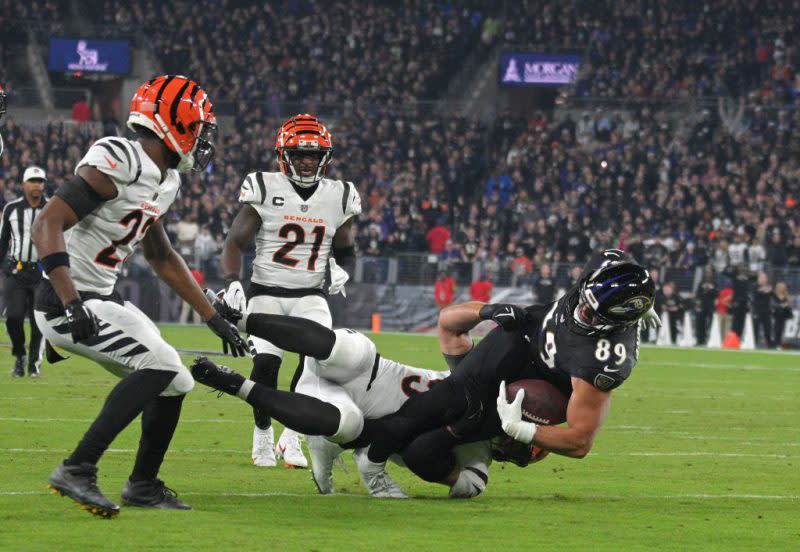What is a hip-drop tackle? NFL owners approve rule banning ‘incredibly injurious’ maneuver

- Oops!Something went wrong.Please try again later.
- Oops!Something went wrong.Please try again later.
(NEXSTAR) – NFL team owners voted to approve several new rules this week, including one that bans the hip-drop tackle, a maneuver acknowledged as “incredibly injurious” by the chairman of the league’s Competition Committee.
This type of tackle, where a defender grabs a runner around the body and uses his own weight to bring the runner down, has been blamed for numerous injuries to players’ ankles and knees. Jeff Miller, the executive vice president of communications at the NFL and the league’s lead executive for Health and Safety Initiatives, once described the move raised the rate of injury over a regular tackle by 25 times.
“It is an unforgiving behavior and one that we need to try to define and get out of the game,” Miller said in October 2023, according to the Associated Press. “To quantify it for you, we see an injury more or less every week in the regular season on the hip-drop.”
The NFL has been flirting with the idea of outlawing the hip-drop tackle (sometimes also known as the “swivel hip-drop tackle”) for some time, with renewed calls for a ban after Baltimore Ravens tight end Mark Andrews suffered a cracked fibula and ankle ligament injury in November 2023. During that game, Andrews had been in possession of the ball, running for the end zone, when a Bengals defender caught Andrews from behind and fell on the back of his left ankle.
Immediately after the play, Andrews could be seen writhing in agony on the ground.
“It doesn’t get used very often, but when it is used, it’s incredibly injurious to the runner,” NFL Competition Committee chairman Rich McKay said Monday, during a meeting in which team owners unanimously voted to approve a rule banning the hip-drop tackle. “The runner is purely defenseless.”
Miller, at Monday’s meeting, added that hip-drop tackles were used 230 times last season, resulting in 15 players missing time with injuries.
Why does the Super Bowl use Roman numerals?
Not everyone is thrilled with the new rule, however. The NFL Players Association — the union representing NFL players — has opposed it, arguing that it restricts the defensive capabilities of players, and would “cause confusion” for everyone on and off the field.
“I feel like this particular rule change, I don’t understand how you can police it the right way and allow us to do our job,” Atlanta Falcons defensive lineman Calais Campbell said earlier this year.
Several current and former athletes spoke out against Monday’s decision on social media, including former Houston Texans defensive end J.J. Watt.
“Just fast forward to the belts with flags on them,” Watt wrote.
Former Chicago Bears offensive lineman Kyle Long, on the other hand, applauded the decision.
“I’m happy the hip drop tackle is outta the game. I’m all for the league trying to minimize the potential for serious injury,” Long wrote on X. “The league has a 100 percent rate of injury but the hip drop tends to be the cause of injuries that are harder to come back from.”
Current, former players react to NFL’s hip-drop tackle ban
Aside from the rule concerning the hip-drop tackle, two other proposals were approved by owners Monday: one would allow a team to receive a third challenge following one successful challenge, whereas teams previously needed to be successful on two challenges to receive a third; and another concerning possession of the ball after a double-foul.
But the most significant rule changes were reportedly adopted Tuesday morning, when NFL owners approved an overhaul to the kickoff.
A source for the Associated Press described the new kickoff rules as follows:
Beginning in 2024 games, the ball will be kicked from the 35-yard line with the 10 kick coverage players lined up at the opposing 40, with five on each side of the field. The return team would have at least nine blockers lined up in the “set up zone” between the 30- and 35-yard line, with at least seven of those players touching the 35. There would be up to two returners allowed inside the 20.
Only the kicker and two returners would be allowed to move until the ball hits the ground or was touched by a returner inside the 20.
Any kick that reaches the end zone in the air can be returned, or the receiving team can opt for a touchback and possession at the 30. Any kick that reaches the end zone in the air and goes out of bounds or out of the end zone also would result in a touchback at the 30.
If a ball hits a returner or the ground before the end zone and goes into the end zone, a touchback would be at the 20 or the play could be returned. Any kick received in the field of play would have to be returned.
“I’m all for it,” Kansas City Chiefs coach Andy Reid said. “You have 2,000 dead plays. Nobody wants to see that. It’ll add excitement and newness.”
The Associated Press contributed to this report.
For the latest news, weather, sports, and streaming video, head to PIX11.


